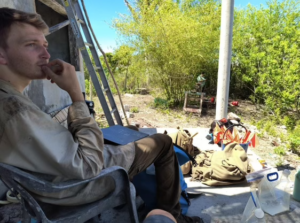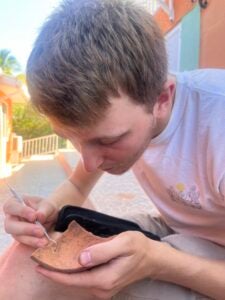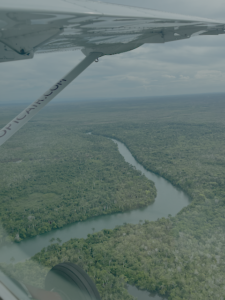I had the amazing good fortune to attend field schools in two English-speaking countries, Belize in Central America and a Caribbean island claimed by Colombia, known as Providence or Providencia. From my midwest home, I flew to the remote Island of Providence and Santa Catalina, while lies in the middle of the Caribbean, 130 miles off the coast of Nicaragua. I met up with the project’s director, Dr. Tracie Mayfield, who runs this research project in collaboration with the Institute for Field Research which provides grant funding. She had organized an incredible place for our team to stay and work. We had views of the sea and very comfortable living conditions at a locally-owned bed and breakfast called Posada Enilda (complete with a bed, AC, running water, and three delicious meals each day).

I learned so much because each field day was different. A common thread was my rising early to a 6:30am wake-up call, breakfast, packing up the ‘mules’ (heavy duty utility vehicles that basically are golf carts on steroids).
Because the island was settled by English Puritans who had hoped to set up a successful plantation on the island until they were ousted by the Spanish, the sites on the north end of the island are town sites established by the English and Spanish. However, the south end of the island is where enslaved people escaped and established sites where they would be out of reach of their former masters. These hidden places, usually in the remote inner parts of the island, are known as Maroon communities.
Excavations normally were done in 10cm arbitrary levels, down to around 30cm using mattocks, shovels, trowels, and brushes. At noon, all teams would pack up and return to the Posada for lunch. For a break, we’d enjoy a card game of Euchre or Spit until 2:00 PM, when work would begin again. This might include lab work (photographing artifacts, washing, cataloging, paperwork, etc). Occasionally, work would resume in the field during this time. By 5:30 PM, we’d gather for inspiring talks from our incredible faculty or from local Raizal community members, culture bearers, and experts, including artists, bush-medicine practitioners, agricultural specialists, and more. These were a unique opportunity to hear about life and cultural ways that largely are unknown beyond the island. Frequently, during or after this time, we would devour delicious Steve’s Jerk Chicken before enjoying some well-earned free time.

During our off time, we had plenty of activities to explore. Sometimes after a particularly dusty day, a group of us would go swimming in the seven-colored blues of the Caribbean Sea, or enjoy cheesecake at a local bakery. Some of us were able to get SCUBA certified and got to explore incredible reefs and see sharks in crystal clear waters. Some evenings, we were fortunate enough to join cultural festivals complete with live music, street food, and regional subtleties.
The most astounding aspect about the trip for me was the kindness of people whom I met on the island. Nearly every island person I met was welcoming, unique, and gracious. A perfect example of this is when I joined Dr. Mayfield on an ethnography session. Although I could not understand most of what was being said, as the language was in a variant of Creole nicknamed by local folks as ‘gypsy’, our ears perked up when we picked up on the words ‘banana cake.’ The woman then proceeded to offer us a slice. It looked so delicious, we ended up buying the whole cake!

Providence is truly a unique and incredible place. As someone who studies ceramics as a Fine Arts double major with Archaeology, the ceramic traditions of Providence Island naturally piqued my interest. I was standing in a place with 400 years of ceramic history that represents all the global flows of Atlantic trade as well as local indigenous traditions. Though much of this history is part of a fascinating story of the European ceramic trade, even more captivating is the local ware made on the island by the native Raizal.
As a ceramicist, I felt the hands and hearts of the people who had made the vessels that I now held as sherds, with many still bearing the fingerprints from Maroons, enslaved people brought from Africa to serve the Puritans and Spanish on their plantations who could escape to remote sites of freedom. Unfortunately, much less is known about this type of ceramic (called colonoware) compared to European pottery. After learning this discrepancy, I decided I would begin to work with this material to better understand it and the people who made it. This will be my goal this upcoming field season, as I try to determine functionality, a method to reliably date sherds, and to learn how these vessels were made.
I find these ceramic items and their associated history to be incredibly important, as it is a direct by-product of people trying to preserve their culture during the African Diaspora. Beyond that, I also look forward to reuniting with the many local people who are superb stewards of a vibrant culture.

Immediately upon finishing work on Providence Island in the Caribbean, I pinballed around Central American airports, eventually reaching Belize! Flying into Belize City, I was met at the airport and taken on a ninety-minute car ride through bucolic and pastoral regions inhabited largely by Mennonites who have developed industries and agricultural capacities across Belize. Eventually, we turned onto a remote gravel road that led into the Rio Bravo Conservation Area, a vast jungle, largely untouched by modern human interference. When I arrived, I was greeted by Dr. Eric Heller and escorted to a two-story bungalow-style dormitory. While it did not have some modern luxuries like flushing toilets or AC, the camp was not the bivouac I expected and, overall, I was quite pleased with the arrangements.
Every day (except Sunday), we began at 6:00 AM with breakfast served at the dining quarters and prepared by Belizean chefs. By 7:00 AM, we loaded into a truck and ventured out of Rio Bravo into a nearby town to pick up local workers. From there, we ventured into a pasture at the top of a large hill, soon reaching the Mayan site of La Milpa North. La Milpa North is a substantial complex that is positioned strategically to command the terrain. It is likely that high status elites lived on this site, perhaps warlords of the immediate surrounding region.
Our work focused on uncovering a large architectural structure that was a potential armory/barracks, which had been constructed largely with limestone and plaster. Our excavation units reached various levels, often achieving a depth of 1m to 1.5m of careful excavation. Around noon, we would break for lunch for an hour and I would enjoy a PB&J sandwich, a banana, and a can of stewed sausages. We would continue work until around 3:00 PM when we would pack up and head back into camp. From there, everyone set off to do their own thing: doing chores, relaxing with a book, playing card games, and socializing. Sometimes, to pass the time after returning from the site, some of my peers and I would do lab work such as piecing together plaster glyphs that must have fallen from a vaulted ceiling. In addition to this, I particularly enjoyed doing lithic analysis on ‘shaft straighteners,’ which are lithics shaped in a particular arc for straightening wood (or potentially even defleshing). I also began rehydrating clay to do some experimental archaeology, yet the firing schedule was thrown off by Hurricane Beryl. Unfortunately, our time in the field was cut short by Hurricane Beryl, forcing us to backfill earlier than anticipated. As a result, we lost several planned excavation days, though we still managed to complete a significant amount of work.
On days off, we would go to the Mennonite version of Walmart for cell service and snacks. Upon returning to camp, people had time to themselves, resting, taking hikes, playing soccer games or cards, reading, doing lab work, and we made the occasional field trip to archaeological sites. Overall, this field school was equally incredible, with truly astounding Mayan architecture being uncovered and innovative research being done.
The work being done here (some of it I’m not allowed to share yet) will be important for a better understanding of Mayans as we know them. I also hope to return next field season to continue working on experimental ceramics and innovative excavation documentation like photogrammetry for VR.
To learn more about these field schools visit:
Providencia: https://ifrglobal.org/program/caribbean-providence-island/
Belize: https://dornsife.usc.edu/flp/home/programs-and-resources/summer-programs/